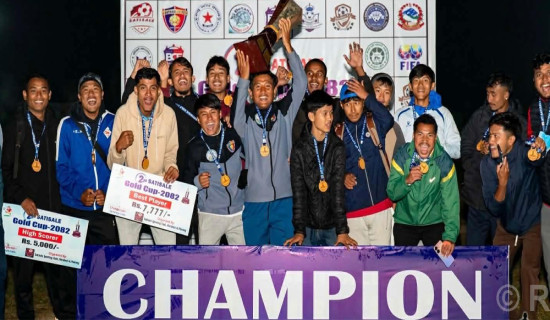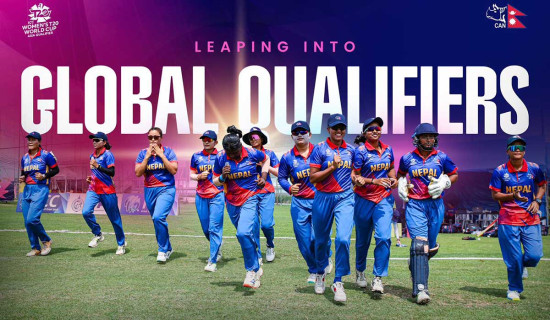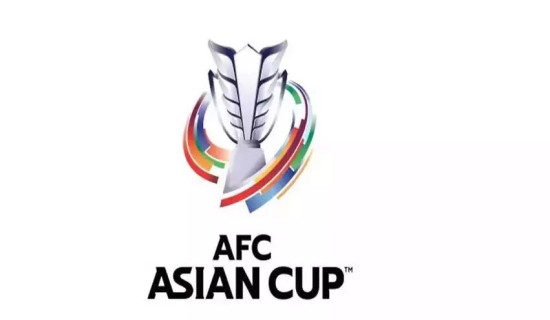- Wednesday, 24 December 2025
Volleyball Players Seek Professional Backing
Volleyball has been one of the common sports across Nepal for many decades; however, in the past seven years, the sport has seen a major transformation thanks to volleyball being declared the national sport of Nepal in May 2017.
Volleyball’s origin dates back to 1895, when William G. Morgan of Massachusetts, USA, invented the game, originally called "mintonette." Similarly, from designing a special ball for the sport in 1900 to being christened ‘volleyball’ in 1952, the sport saw several developments that led it to reach the corners of the world.
Volleyball debuted at the 1964 Tokyo Summer Olympics in the men's and women’s categories. In Nepal, the sport arrived via Nepalis serving in the British Army in the mid-1930s. After four decades of struggle for prominence in a rural country with geographical challenges, the first national volleyball tournament between 13 of the 14 zones organised in 1973 gave a new platform for the sport.
Nepal’s major debut in volleyball came at the 1978 Asian Games hosted by Thailand in the men’s category. Since then, the men’s team has participated in the Asian Games in 1982 and 1986. Volleyball, along with other sports, was undermined in Nepal due to turbulence in the authoritarian system.
After a long gap and a minor increment in investment as the national sport, Nepal’s men’s and women’s teams participated in the 2022 Asian Games; however, the teams have not won any major medals in the tournament so far.
Nevertheless, the performances in other international tournaments, such as the AVC Central Zone Senior Men’s Volleyball Tournament and the Central Asian Volleyball Association's (CAVA) Women’s Challenge Cup, have shown the capabilities of Nepali volleyball players.
Promising teams
Nepal’s men’s volleyball team has played in the AVC Central Zone tournament five times (2015–2019). The team won a bronze medal once in those tournaments. On the other hand, the Nepali women’s team won two of the three CAVA Women’s Challenge Cups in 2019 and 2021; the team won a bronze in 2023.
The men’s team is also waiting for a medal in the South Asian Games; however, the women’s team, since 1999–2019, has won three bronze and two silver medals in the South Asian Games.
The Asian Central Zone championships provided a platform for the country to showcase its talent in volleyball. However, while other countries in the tournament improve their gameplay in every edition, Nepal’s development has not been sufficient.
The promising Nepali players are unable to raise their standards due to the lack of support from the authorities. Nepal does not have a well-equipped covered volleyball hall. The best one in Dasharath Rangasala can accommodate 1,000 viewers, but the hall lacks fans or air conditioners for the fans. In the 8th PM Cup: NVA Women/Men Volleyball League (June 1–8), audiences watched the matches while sweating for hours. The national team does not organise regular training for the national players; they are called around a month before an international tournament.
On other days, the national players train with the departmental teams they are associated with. However, according to departmental clubs, only Tribhuwan Army Club has a volleyball court with a proper mat. The other two clubs train their players on open ground. Digital technologies confirm difficult decisions, such as whether the ball touched the line or not and whether a player touched the net or line or not, in international events. However, such technology is currently a dream for a country without a proper hall. Nevertheless, the formation of non-governmental or departmental volleyball clubs, such as Help Nepal Sports Club, Everest Volleyball Club, and Chandragiri New Diamond, has shown more promise in volleyball.
Players and coaches, when asked about the condition of volleyball in Nepal during the 8th PM Cup, stressed that the country’s volleyball could start challenging professional teams globally if they receive better training facilities. The organisation of a championship cup and a league cup annually by the Nepal Volleyball Association with support from the government has been a major boost for domestic volleyball players. Moreover, Nepali clubs are also bringing in foreign players, showing an increasing interest in sponsorships in volleyball.
The National Sports Council’s member-secretary, Tanka Lal Ghising, informed the media during the final of the 8th PM Cup that the government, for the next fiscal year, had allocated a budget to install air conditioners at the covered hall in Dasharath Rangasala alongside the construction of a training centre for volleyball. Despite the assurances, the fraternity awaits their implementation, as assurances are not new in the sports sector.
Immense public support
Other than the local volleyball tournaments organised across the corners of the Himalayan, Hilly, and Tarai districts, at least a dozen national-level volleyball tournaments are organised in Nepal annually.
Those tournaments lack a proper court and other basic facilities but have never seen a shortage of audiences.
Out of the several tournaments, the crowd of fans in the final of the 34th National Men’s Volleyball Competition organised in the open ground of Birendranagar, Surkhet, in January this year was a sight to behold. Buses were parked around the makeshift court and used as parapets. People had climbed trees and buildings to get a peek into the match.
Similarly, the crowd in the different editions of the Tiger Cup has also proven the passion of Nepalis towards volleyball outside the Kathmandu Valley.
Moreover, Nepalis accept that volleyball is more popular in rural areas. Many players from rural Nepal have played on the national team.
The annual President Running Shield tournament demonstrates the production of a new generation of Nepali volleyball players; however, authorities have failed to retain them, improve their skills, and have them represent the country by earning a livelihood out of the sport. Thus, when volleyball is the national sport and the love for the sport amongst Nepalis only increases, the sport needs more professional attention.
(The author is a journalist at The Rising Nepal.)









-original-thumb.jpg)







